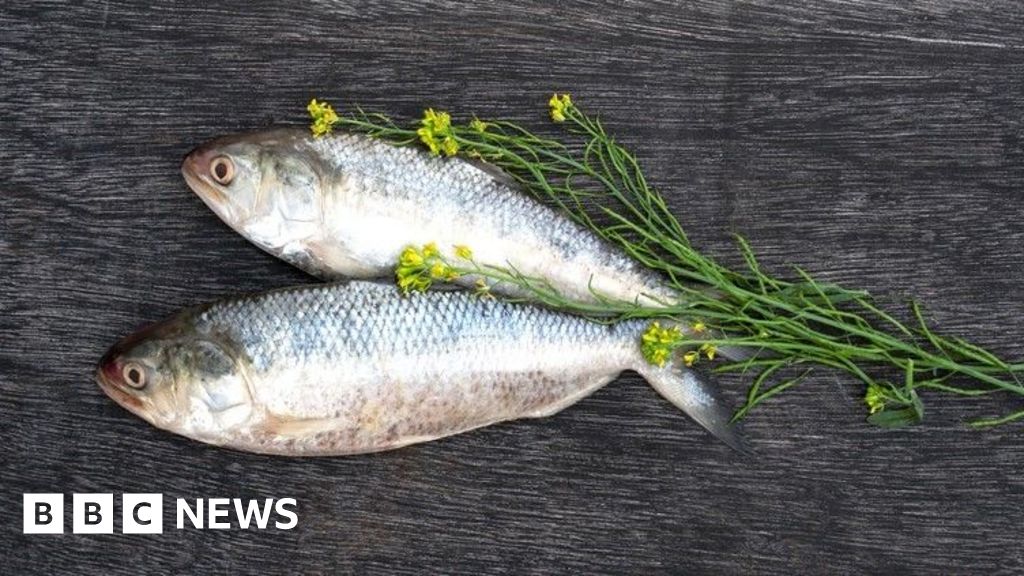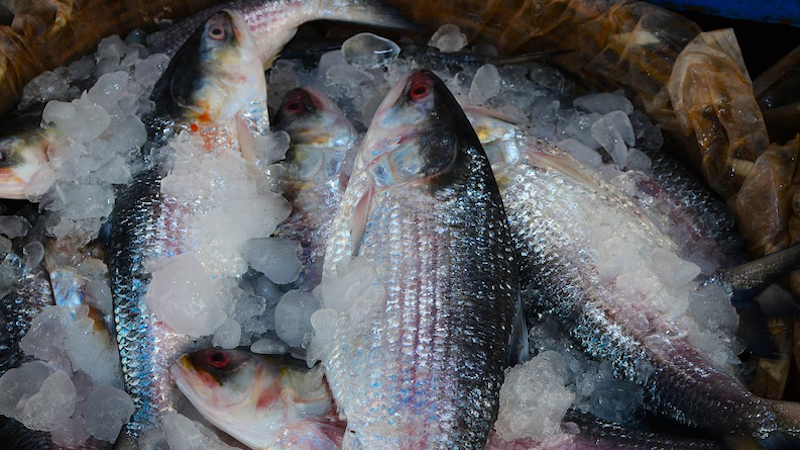Saif
Senior Member
- Messages
- 14,629
- Reaction score
- 7,628
- Origin

- Residence

- Axis Group

Date of Event:
Jul 24, 2025
Conservation and sustainable harvesting of Hilsha fish
Mushfiqur Rahman
Published :
Jul 23, 2025 22:59
Updated :
Jul 23, 2025 22:59

Price of Hilsha (Ilish) fish, the national fish of Bangladesh continues to soar in the local markets. A 800 gm to 1.0 kg size hilsha fish was sold at a price varying from Taka 2,500-2,800 in Dhaka fish market on July 09, 2025. On the contrary, the same size hilsha fish was sold at a price ranging from 2,800-3,000 per kilogram at the 'boro bazar' of Chandpur the previous day. A 1.2 kg-1.5 kg size hilsha was traded at a price ranging from Taka 3,500 to 4,000 at Chandpur wholesale market during early July 2025. Traditionally Chandpur has been considered as one of the main wholesale markets for hilsha in the country. Hilsha traders have been claiming at the Capital's Karwan bazar wholesale market that the supply has been declining. In addition, the cost of fishing, carrying, conservation including for icing of hilsha fish, labour cost etc. have been increasing consistently with impacts on prices in the market.
Hilsha fish is being harvested and supplied to local market throughout the year but the peak season for harvesting is June to October. Other open water fish supply remains low in the market during that period of the year. However, good supply of hilsha in the market during the lean period of fish supply helps to keep the supply side balanced..
Researchers of the Bangladesh Fish Research Institute (BFRI) at the Riverine centre of Chandpur, and the officials of the Department of Fisheries report that fishermen in Bangladesh harvest annually on average 5.5 lakh tons of hilsha. Among the harvested hilsha, 55 per cent are caught in the Bay of Bengal and 45 per cent in the estuary of the river Meghna and in the rivers and tributaries of the Ganges and Meghna river systems. The government has imposed ban on hilsha fish export despite its high demands in the countries where Bengali hilsha fish lovers live. During 2023-2024, only a token 665 tons of hilsha was exported.
Traditional fishing patterns for hilsha have been changing with the involvements of different types of nets, mechanised boats requiring higher capital investment. Now a days, small-scale fishermen seldom can sustain the cost of fishing hilsha. Usually investors lend money to small hilsha fishermen for organising boat, net and other fishing gears, operating costs, fuel oil, food, ice etc. on the condition of sharing the harvest. Marine hilsha fishing is more capital intensive.
Hilsha is the single largest open water fish species of Bangladesh. It inhabits in a wide range of open water environment. This fish species alone contributes 12 per cent of total fish production in the country. Scientists of BFRI opine that Bangladesh shares about 75 per cent of hilsha fish harvest in the world. Apart from Bangladesh, hilsha is harvested in India (5 per cent), Myanmar (15 per cent) and in other countries including Pakistan, Iran, Iraq, Thailand, Malaysia, Indonesia, Laos and Vietnam. Approximately, 6.5 lakh people are directly involved in hilsha fishing in Bangladesh. About 20-25 lakh people in the country are involved with hilsha fish harvesting and associated livelihoods including making nets and netting equipment, fish transportation, ice making, packaging, marketing etc.
Currently, Hilsha fishes are found in the lower Padma and Meghna rivers (in 100 rivers and streams of 38 districts of Bangladesh) and in their tributaries as well as in the estuary of the lower Meghna rivers, Bay of Bengal. However the abundance of hilsha fish is progressively declining in the inland river systems and it has already disappeared from 30-40 rivers due to serious reduction of water flow and river water depth, pollution (industrial and domestic and agricultural chemical pollution). Besides, pollution level of the rivers Buriganga, Shitalakhya and upper Meghna rivers have been alarmingly raising. In addition, different flood protection structures, cross dams, spars, bridges built in the river systems have been hindering free movements of the fish.
Mature hilsha fish (brood hilsha) travels from the Bay of Bengal to the Ganges-Meghna estuary and further upstream mainly for spawning and breeding, as there is abundance of food (phyto-plankton and zooplanktons) available in the sweet waters of the rivers and suitable water quality for juvenile (jatka) hilsha fish. Unfortunately, Jatka attracts fishing during November to March-April. As a result, serious damage is being done to hilsha fishery every year. The naturally renewable resource can not replenish fully the declining fish stock. Unless over-fishing of jatka could be checked and the suitable habitat for hilsha fish can be maintained, it will be challenging to restrict hilsha population decline.
The government has declared 5 hilsha fish sanctuary and identified one more area to help develop undisturbed breeding and jatka nursery. Department of Fisheries has taken various initiatives to assist fishermen dependent on hilsha fishing providing financial and food help, training and support for alternative livelihood. The government has banned hilsha fishing during October13 -November 03 to enable them grow fast. Various government organisations involving river police, coast guards and Bangladesh Navy patrol the breeding grounds and nursery areas of hilsha.These initiatives have partly helped in protecting jatkas and their growth.
As per published data, hilsha production was 1.99 lakh tons during 2003-2004, and reached nearly 5.50 lakh ton during 2023-2024 period. But consumer demands have grown manifold too. Chief Scientific Officer at the Riverine Centre of BFRI, Chandpur Dr. Amirul Islam and his team estimated that during 2023-2024, approximately 44.24 thousand crore jatka had successfully been added to hilsha fish stock in the country's water bodies. It is a challenge for all to secure the jatkas to become mature and healthy for successful replenishment of the valuable natural resource.
Mushfiqur Rahman is a mining engineer writes on energy and environment issues.
Mushfiqur Rahman
Published :
Jul 23, 2025 22:59
Updated :
Jul 23, 2025 22:59
Price of Hilsha (Ilish) fish, the national fish of Bangladesh continues to soar in the local markets. A 800 gm to 1.0 kg size hilsha fish was sold at a price varying from Taka 2,500-2,800 in Dhaka fish market on July 09, 2025. On the contrary, the same size hilsha fish was sold at a price ranging from 2,800-3,000 per kilogram at the 'boro bazar' of Chandpur the previous day. A 1.2 kg-1.5 kg size hilsha was traded at a price ranging from Taka 3,500 to 4,000 at Chandpur wholesale market during early July 2025. Traditionally Chandpur has been considered as one of the main wholesale markets for hilsha in the country. Hilsha traders have been claiming at the Capital's Karwan bazar wholesale market that the supply has been declining. In addition, the cost of fishing, carrying, conservation including for icing of hilsha fish, labour cost etc. have been increasing consistently with impacts on prices in the market.
Hilsha fish is being harvested and supplied to local market throughout the year but the peak season for harvesting is June to October. Other open water fish supply remains low in the market during that period of the year. However, good supply of hilsha in the market during the lean period of fish supply helps to keep the supply side balanced..
Researchers of the Bangladesh Fish Research Institute (BFRI) at the Riverine centre of Chandpur, and the officials of the Department of Fisheries report that fishermen in Bangladesh harvest annually on average 5.5 lakh tons of hilsha. Among the harvested hilsha, 55 per cent are caught in the Bay of Bengal and 45 per cent in the estuary of the river Meghna and in the rivers and tributaries of the Ganges and Meghna river systems. The government has imposed ban on hilsha fish export despite its high demands in the countries where Bengali hilsha fish lovers live. During 2023-2024, only a token 665 tons of hilsha was exported.
Traditional fishing patterns for hilsha have been changing with the involvements of different types of nets, mechanised boats requiring higher capital investment. Now a days, small-scale fishermen seldom can sustain the cost of fishing hilsha. Usually investors lend money to small hilsha fishermen for organising boat, net and other fishing gears, operating costs, fuel oil, food, ice etc. on the condition of sharing the harvest. Marine hilsha fishing is more capital intensive.
Hilsha is the single largest open water fish species of Bangladesh. It inhabits in a wide range of open water environment. This fish species alone contributes 12 per cent of total fish production in the country. Scientists of BFRI opine that Bangladesh shares about 75 per cent of hilsha fish harvest in the world. Apart from Bangladesh, hilsha is harvested in India (5 per cent), Myanmar (15 per cent) and in other countries including Pakistan, Iran, Iraq, Thailand, Malaysia, Indonesia, Laos and Vietnam. Approximately, 6.5 lakh people are directly involved in hilsha fishing in Bangladesh. About 20-25 lakh people in the country are involved with hilsha fish harvesting and associated livelihoods including making nets and netting equipment, fish transportation, ice making, packaging, marketing etc.
Currently, Hilsha fishes are found in the lower Padma and Meghna rivers (in 100 rivers and streams of 38 districts of Bangladesh) and in their tributaries as well as in the estuary of the lower Meghna rivers, Bay of Bengal. However the abundance of hilsha fish is progressively declining in the inland river systems and it has already disappeared from 30-40 rivers due to serious reduction of water flow and river water depth, pollution (industrial and domestic and agricultural chemical pollution). Besides, pollution level of the rivers Buriganga, Shitalakhya and upper Meghna rivers have been alarmingly raising. In addition, different flood protection structures, cross dams, spars, bridges built in the river systems have been hindering free movements of the fish.
Mature hilsha fish (brood hilsha) travels from the Bay of Bengal to the Ganges-Meghna estuary and further upstream mainly for spawning and breeding, as there is abundance of food (phyto-plankton and zooplanktons) available in the sweet waters of the rivers and suitable water quality for juvenile (jatka) hilsha fish. Unfortunately, Jatka attracts fishing during November to March-April. As a result, serious damage is being done to hilsha fishery every year. The naturally renewable resource can not replenish fully the declining fish stock. Unless over-fishing of jatka could be checked and the suitable habitat for hilsha fish can be maintained, it will be challenging to restrict hilsha population decline.
The government has declared 5 hilsha fish sanctuary and identified one more area to help develop undisturbed breeding and jatka nursery. Department of Fisheries has taken various initiatives to assist fishermen dependent on hilsha fishing providing financial and food help, training and support for alternative livelihood. The government has banned hilsha fishing during October13 -November 03 to enable them grow fast. Various government organisations involving river police, coast guards and Bangladesh Navy patrol the breeding grounds and nursery areas of hilsha.These initiatives have partly helped in protecting jatkas and their growth.
As per published data, hilsha production was 1.99 lakh tons during 2003-2004, and reached nearly 5.50 lakh ton during 2023-2024 period. But consumer demands have grown manifold too. Chief Scientific Officer at the Riverine Centre of BFRI, Chandpur Dr. Amirul Islam and his team estimated that during 2023-2024, approximately 44.24 thousand crore jatka had successfully been added to hilsha fish stock in the country's water bodies. It is a challenge for all to secure the jatkas to become mature and healthy for successful replenishment of the valuable natural resource.
Mushfiqur Rahman is a mining engineer writes on energy and environment issues.








